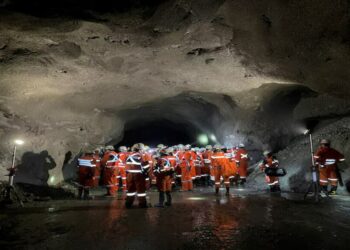Rio Tinto, WesTrac and Caterpillar have embarked on a project to deploy a new tele-remote dozing system (TDS) at Rio iron ore operations in Western Australia that, they say, is wholly focused on operator safety.
Utilising Cat MineStar Command for Dozing and a dedicated operator control centre, Rio Tinto solution allows for non-line of sight operation of dozers working in high-risk areas.
Rio Tinto Superintendent Process and Technical, Michelle Woolcock, says the overarching brief was to effectively manage potential safety risks associated with dozers working in areas that were more susceptible to risk.
“The brief was to take the operator out of the line of fire,” Woolcock said. “In particular, the focus was to reduce the risk of operators being in machines that faced a risk of slipping or stability issues, for example when they were working on stockpiles or close to steep walls.”
There are multiple layers of technology and control options involved in the solution, depending on client and site-specific requirements.
Caterpillar Senior Service Engineer, Steve Dougherty, explained: “To start, you need the base remote-control kit. There are different kits available for each machine size. If you wanted to do some basic remote-control work, there’s a kit that includes a console receiver, which is a dedicated wireless link installed on top of the cab.
“There a Remote Control Module (RCM) that gets installed under the seat and interfaces with all the base machine functions, and the associated wiring and Wi-Fi network to allow the various parts to communicate.”
The solution includes options for controlling machines within visual range, consisting of an over-the-shoulder console and a dedicated network, which Dougherty says is typically suited to operators needing to perform temporary or one-off, high-risk applications.
“You could run that way all day if you wanted to, but the units are set up with dead-man switches so are really designed for things like machine recovery,” he explained.
“For more long-term applications, like the one that Rio Tinto is rolling out, we set up an operator station which looks very much like a simulator with all the in-cab controls replicated. It can still be run as a line-of-sight solution, but more typically customers opt for the vision kit, which adds four cameras on board the dozer and utilises a customer-supplied Wi-Fi network to relay all of that machine information and the video feeds to the operator station, wherever it may be located.”
While Dougherty says the remote station solution can allow a single operator to control up to five machines at one time in some circumstances, such as strip mining operations, Rio Tinto solution is purely designed to move operators into a safer, more comfortable operating environment.
Rio Tinto Superintendent Operational Readiness, Jamie Webster, says the initial rollout of the TDS at the Cape Lambert Port facility, north east of Karratha, is focused on high-risk operations on coarse ore stockpiles with steep gradients and “live” areas where ore is fed into underground tunnels.
“Safety is the number one priority at all Rio Tinto sites and for all employees,” Webster says.
“The message at all levels is that safety always comes first. Every single person on site, from leaders to cleaners, are empowered to stop if they ever feel unsafe and we always look at ways to improve processes so that no one is in harm way.”
According to Webster, the TDS project is one such area where process improvements were identified to reduce risk.
“These dozers are operating in quite a tight area around lots of fixed assets,” he explained. “That means work is quite intricate and the real benefits will be realised in pushing ore from the stockpiles into the live zones.
“The dozers are working at the top of a large stockpile and if a dozer slips it could go down a bank, or if it’s working while the apron feeder is operating, the ground could fall away from underneath it. Obviously, we already have processes in place and technology to mitigate such risks, but putting the operators into a station away from the danger zones eliminates any potential risk to them being harmed, no matter how small that risk might be.”
While removing operators from high-risk zones is driving the rollout of the solution, Woolcock says it does not mean removing operators from site.
She says remote operators still need to be “close to the action” and have detailed site knowledge to function most effectively and efficiently. “As much as ‘non-line-of-sight’ operation sounds like it could be carried out from anywhere, the reality is that these operators are multi-tasking in their roles,” she says.
“It will depend on the state of the coarse ore stockpile and what’s coming in and going out. They need to be able to visually inspect and determine what needs to be done. They might spend an hour or two dozing then move on to other tasks while they wait for the stockpiles to be replenished.
“When you need dozer operators, you typically need all hands on deck, and when you don’t need them, if they’re sitting in a control centre hundreds of kilometres away, it’s far more difficult to stay on top of other tasks they might carry out on site.”
Woolcock and Webster admit there was some resistance among the first operators to be trained in TDS, but as they became more familiar with the solution, the operators embraced it.
“A lot of operators quite literally work the dozers through their seats,” Webster says. “They might have worked for decades and are accustomed to feeling the movement. So they’re having to relearn how to drive the dozer without that sense of movement, and they’re relying entirely on the visual feed of information rather than the other senses from being in the mobile rig.”
According to Woolcock, the key to operator acceptance has been allowing them time to use the system and understand the difference the cutting-edge technology will make.
“With the on-the-job trainers (OJTs), they were excited initially to have the chance to learn something novel,” Woolcock says.
“Once the training commenced, a lot of them got quite downhearted because as experienced dozer operators, they had the sense they were going right back to relearning all the knowledge they built up over years of manual operation. So they felt like they were starting the first day of school again.
“But it was very much a case of them moving through the classic stages of learning until they had a feel for it and got to that level of conscious competence.
“The transition from resistance to acceptance to championing the new way of working was amazing and I think it was because the OJTs realised they were pioneering new technology.”
Woolcock says two or three operators across each of the Cape Lambert work crews will ultimately be trained in the TDS operations, while the technology is being progressively rolled out across other Rio Tinto sites.
For WesTrac Technology General Manager, Alister MacPherson, the progressive rollout has necessitated a range of adjustments within the mining technology team and rollout methodologies. With multiple deployments, WesTrac aims to identify the repeatable parts of the process and ensure adequate resourcing to fulfil the relevant roles and responsibilities.
“We want as much as possible to roll this out as a programme of work rather than a series of individual projects,” MacPherson says.
“That means firstly ensuring we have completed the right training in areas including product management, project engineering and technical support, then developing a collaborative approach between WesTrac and Rio Tinto to ensure the program is rolled out smoothly.”
WesTrac Product Manager – Mining Technology, Gary Scott, says the Cape Lambert project provided an ideal proving ground to develop the rollout strategies that can be extended to other sites.










